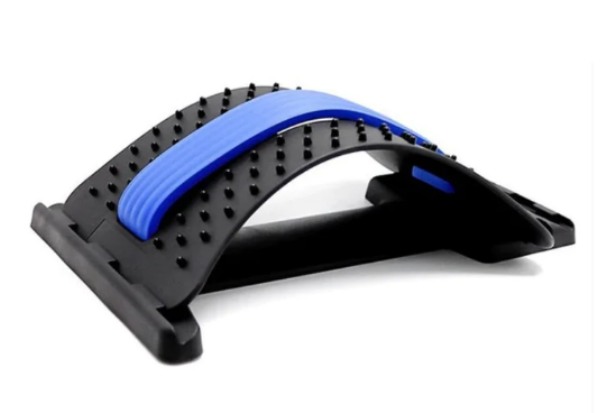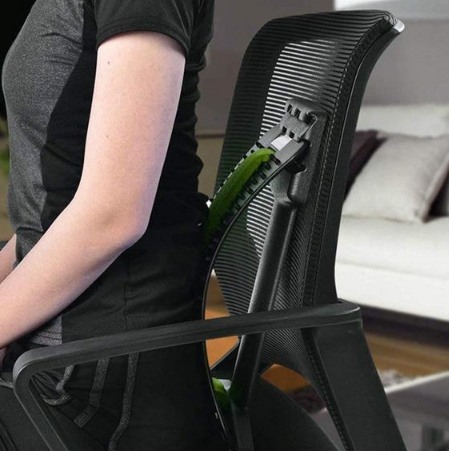
Using a back stretcher to ease some of the pain and compression in the spine is easy with the help of this simple guide.
How do back stretchers function is a common query that we receive. While some people can afford a personal physical therapist to come to their home daily to help relieve back pain with therapeutic traction and stretching, the vast majority of us have to find other ways to rehabilitate and treat spine pain. A straightforward tool called a back stretcher may be able to help you stretch out your back to relieve some of the pain and compression in your spine, whether your back pain is brought on by an injury or a degenerative condition like osteoporosis. You can also try some yoga poses that we’ll cover later in the article to stretch your back.
What is a Back Stretcher?
A floor back stretcher is a piece of medical equipment that is typically made of plastic or wood. It has a rounded portion facing up and rests flat on the ground while weighing only a few pounds. You lay on the stretcher with your face up and the part of your back you want to stretch over its curve. Your back should feel slightly stretched as you lay on the curve.
HOW DOES Back Stretcher WORK?
A smaller gap between the intervertebral discs, which results in problems like reduced blood flow and pinched nerves, is the primary cause of back pain. It’s easy to improve the condition of your spine and relieve muscle stiffness by stretching your back. The back stretcher relieves back pain by lengthening the spine and promoting circulation.
With the flexible back stretcher, you can customize four different stretch levels. Gravity makes it possible for your front to stretch out and upwards while you’re lying down. As the muscles in the area begin to relax, the vertebral discs in your spine are gently decompressed, your spine is realigned, and pain and tension are reduced. It feels so good, you’ll be amazed!
HOW to USE Back Stretcher?
To get better results, we advise using the back stretcher for 5 to 10 minutes twice daily. Below you find a step by step guide to set up properly your Back Stretcher:
- With the end of the base facing your direction, position the arch and base on a flat surface.
- Get down on your knees to adjust the wider side of the arch at the base’s end and stabilize the base.
- Put some pressure on the base’s end with your knees in order to bend the arch.
- Laying on top of the arch after adjusting it to the desired level will begin stretching your back.
Health Benefits of a Back Stretcher
There is a lot of evidence that stretching can reduce back pain, but there isn’t much clinical research on the specific health advantages of using a back stretcher. A back stretcher can be a beneficial addition to your stretching routine when used correctly.
A study of nurses in Taiwan who work on their feet most of the day showed that stretching regularly improved their back pain. Meanwhile, a 2016 study in the journal Healthcare reported that an exercise regimen including stretching can increase range of motion for the spine, which makes it easier to do normal daily activities.
Back pain may be relieved by using equipment for back muscle stretching. One study in the journal Work found that becoming more active and doing exercises with minimal equipment, such as rolling the lower back over a hard ball on the floor, can effectively alleviate lower back pain. An alternative to a ball is a back stretcher, which covers a larger portion of the back.

Who Should Use a Back Stretcher?
According to their doctor, people with low-grade, chronic pain that doesn’t require surgery may benefit from using a back stretcher to ease their suffering. “They may have a few weeks of pain that’s not severe—it’s just bothering them, which is a lot of us,” says a thick, rolled-up blanket or yoga mat can provide the same relief as a back stretcher, Dr. Shamie continued.
“Back pain is a very common problem for everyone,” says Dr. Shamie. “In their lifetimes, 90% of people will experience low back pain.” Fortunately, he continues, if it’s not caused by an accident, lifting a heavy object, or a medical condition, it usually goes away on its own.
However, before attempting to treat the pain on your own, speak with your doctor if it persists or you are unable to determine the cause. “Unless you understand the reason for the pain, the treatment you choose could be useless or potentially harmful,” says Dr. Shamie.
Back Stretchers Vs Inversion Tables
Both inversion tables and floor back stretchers are intended to assist you in extending your back muscles, but they function in different ways.
Inversion tables use a narrow, flat surface to securely fasten your body before tipping backward and angling it upside-down to stretch your back and relieve pressure on the spine. Only a brief period of time should be spent in this position at a time, according to experts.
A floor back stretcher offers a different kind of stretch in the meantime. As long as it’s comfortable for you, you can position your body so that your attention is on the part of your back that is tense. “An inversion table doesn’t hyperextend your back as much as a back stretcher,” adds Dr. Shamie.
What to Consider When Buying a Back Stretcher
When looking to buy a back stretcher, keep the following things in mind.
Purpose
Do you want to incorporate a back stretcher into your yoga or stretching routine, lessen stiffness from long stretches of sitting at work, or get rid of any back pain you might experience occasionally? For any of these causes, back stretchers might be worth a try because they aren’t typically an expensive piece of equipment. Before buying a back stretcher, however, be sure to consult your doctor if you are experiencing severe or unexplained back pain.
Adjustability
Many back stretches are adaptable and can be set at various arch heights. For beginners, a back stretch can be achieved by placing an adjustable back stretcher in the lowest arch position. From there, the arch height can be increased to your desired level of comfort.
Wooden back stretchers are strong but frequently not adjustable.
Size
Stretchers for the back usually weigh between 1.5 and 3 pounds. While they come in a variety of sizes, most are roughly 14 inches long and 10 inches wide. You might want to look for a stretcher with a wider width if your back is wide.
Back stretchers are compact enough to fit under your bed, in a closet, or to keep nearby in your home yoga or workout area.
Design
Back stretchers are svelte and uncomplicated; they don’t require batteries, lights, or apps to operate. They are made with a curved top that faces up and a rectangular base that rests on the floor. Some models feature tiny protrusions that gently massage your back as you lie on them. The majority of back stretchers are made of plastic and are available in the colors black, blue, or gray; however, wooden versions are also available.
Weight Capacity
Despite only weighing a few pounds, back stretchers are designed to support bodies up to a few hundred pounds. Back stretchers have a safe weight limit of 220 pounds, and more robust models can support up to 300 pounds. Before making a purchase, check for details about the product’s maximum weight capacity on the packaging or the manufacturer’s website.
Cost and Warranty
Back stretchers can cost anywhere between $8 and $50. There is no warranty information online, despite the fact that some manufacturers give customers a money-back guarantee if they are dissatisfied with their purchases.
Yoga Poses for Stretching Your Back
For patients with high blood pressure, glaucoma, and heart disease, performing a supported legs-up-the-wall yoga posture is an additional way to obtain the therapeutic benefits of inversion and back stretching for nothing and with less risk of harm.
- The baseboard of a wall should have a bolster placed lengthwise along it.
- Your left hip should touch the wall as you sit on the bolster.
- Swing your legs up the wall as you turn your body so that your bottom is resting against the wall and your legs are straight up and resting on the wall. The bolster can be anywhere that is comfortable, from just under your sacrum to the lumbar region of the back (for more stretching in that area)
- Lay completely back, arms outstretched in a T position.
For as long as you like, you can rest in this position. For intense relaxation, use a lavender-scented eye pillow, or play some yoga nidra or guided meditation. The posture can be broken by rolling to one side.
Another more vigorous way to lengthen and stretch your vertebrae if you are more active and have some experience is the yoga pose downward facing dog. When performed correctly, this one can also aid in loosening up the hamstrings and neck muscles. To relieve back tension if your hamstrings are tight, try the child’s pose or the straightforward dolphin pose.
